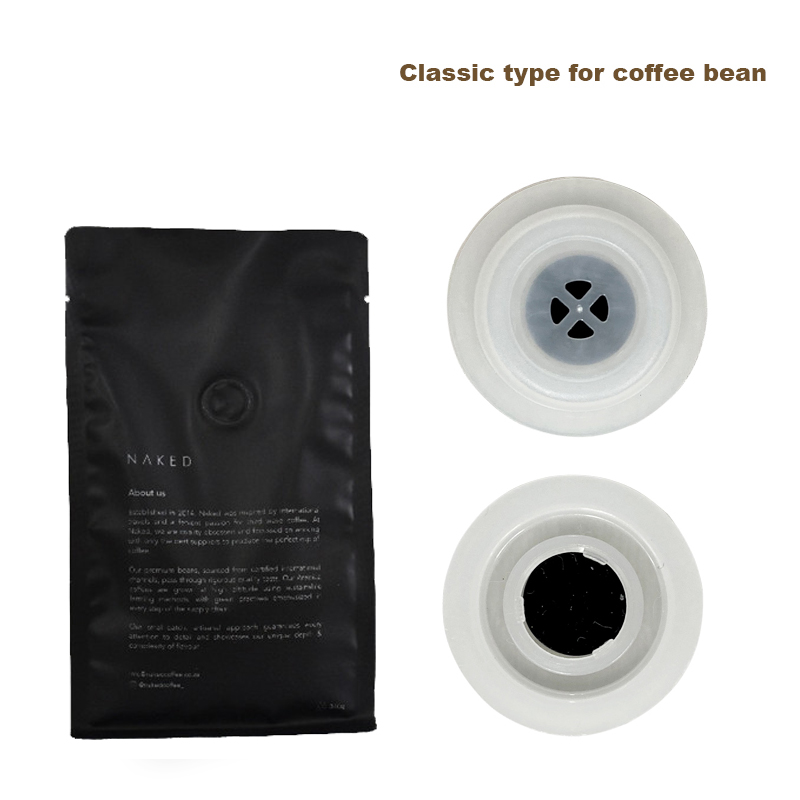A coffee bag with a valve is a type of packaging specifically designed for storing and preserving freshly roasted coffee beans. These bags have become popular in the coffee industry because they offer several advantages over traditional coffee packaging methods. Here's what you need to know about coffee bags with valves:
Coffee Bag With Valve Freshness Preservation: Coffee beans release gases, including carbon dioxide, after the roasting process. If these gases are trapped in the bag without a way to escape, they can lead to the bag bursting or the coffee beans becoming stale. A valve on the coffee bag allows these gases to escape while preventing air from entering the bag. This helps maintain the freshness and flavor of the coffee.
Coffee Bag With One-way Valve: The valve is designed as a one-way system. It permits gas to exit but doesn't allow air to enter the bag. This is crucial because oxygen can cause coffee beans to oxidize and degrade in quality.
Coffee Bag With Valve Extended Shelf Life: Coffee bags with valves can extend the shelf life of coffee beans compared to bags without valves. This means that customers can enjoy the coffee's flavor and aroma for a longer period after purchase.
Coffee Bag With Valve Coffee Roasting: Coffee beans are typically roasted just before they are packaged to maximize freshness. The one-way valve is essential in allowing the beans to degas while preventing external air from affecting their quality.
Coffee Bag With Valve Bag Types: Coffee bags with valves come in various types and materials, such as foil-lined bags, kraft paper bags, and plastic bags. The choice of material can affect factors like light exposure and moisture resistance, which are important for coffee storage.
Coffee Bag With Valve Roast Level: Coffee bags with valves are especially popular for medium and dark roast coffee beans, which produce more gases during and after roasting. However, they can also be used for lighter roast coffee.
Coffee Bag With Valve Degassing Period: Coffee beans typically go through a degassing period after roasting, during which the most significant release of gases occurs. The length of this period can vary depending on the roast level and bean type. Coffee bags with valves allow this process to happen without compromising freshness.
Impacts of the Degassing Period on Coffee:
The Degassing Period has several significant impacts on the taste and texture of coffee, making it a critical phase in coffee production:
Improved Flavor: Freshly roasted beans may exhibit sharp or pronounced acidity due to the release of CO2 gas. As the Degassing Period progresses, this acidity diminishes, resulting in a more balanced and smooth flavor profile.
Preservation of Freshness: The Degassing Period plays a vital role in preserving the freshness of coffee. During this phase, the continuous release of CO2 gas helps to prevent oxygen from entering the beans, thus extending the coffee's shelf life.
Brewing Time: The Degassing Period can influence brewing and extraction times. Coffee beans that have recently completed degassing may require adjustments to brewing parameters to achieve optimal results.
Packaging and Sales: Coffee producers often wait until the Degassing Period is complete before packaging and selling their coffee. At this stage, coffee bags may incorporate one-way valves to release any remaining CO2 gas gradually.
In summary, a coffee bag with a valve is a packaging solution designed to preserve the freshness of coffee beans by allowing gases to escape without permitting external air to enter. This helps extend the shelf life of the coffee and ensures that customers can enjoy a flavorful cup of coffee for an extended period after purchase.
Coffee Bag With Valve Maintaining Freshness: The primary function of a one-way valve is to ensure the freshness of the coffee. By allowing the carbon dioxide gas produced by the coffee beans to escape, the valve prevents the accumulation of gas inside the bag, reducing the risk of bag rupture. This also helps in preserving the coffee's flavor and aroma.
Coffee Bag With Valve Reducing Oxygen Exposure: Oxygen is one of the main factors contributing to coffee oxidation and degradation. A one-way valve prevents oxygen from entering the coffee bag, thereby extending the coffee's shelf life.
Coffee Bag With Valve Eliminating Waiting Post-Packaging: Since the one-way valve allows gas to escape, coffee can be sold immediately after packaging without the need to wait for gas release to complete. This provides higher production efficiency.
Coffee Bag With Valve Choice of Packaging Materials: Coffee bags can be made from various materials, including paper, polymers, and aluminum foil, to cater to different needs. These bags typically also have sealing features to ensure coffee remains fresh after packaging.
Coffee Bag With Valve Retailer-Friendly: For coffee producers and retailers, one-way valves in coffee bags provide a means to offer high-quality, fresh coffee, enhancing product competitiveness.

Coffee Bag With Valve Silicone Duckbill Valve:
Coffee Bag With Valve Peel and Seal Valve:
Coffee Bag With Valve Filter Paper Valve:
Coffee Bag With Valve Plastic Disc Valve:
Coffee Bag With Valve Spring-Loaded Valve:
Coffee Bag With Valve Biodegradable Valve: